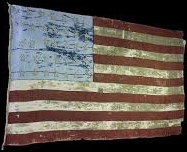by Ski Ingram

It was 1971 when Mary Hoff, a member of the National League of American Prisoners and Missing Action in Southeast Asia, realized the need for a national symbol to represent our POW’s and our MIA’s. Mary Hoff was the wife of Lieutenant Commander Michael G. Hoff who was shot down while flying a reconnaissance mission over Laos. Michael G. Hoff, who was later promoted to Commander, launched his Sidewinder A7A Corsair aircraft off the deck of the USS Coral Sea on January 7, 1970. While strafing ground troops he reported that his aircraft was on fire and he was going to bail out. Other pilots in his flight reported seeing his aircraft hit the ground, but they were unable to determine if he had bailed out.
Mary contacted Norman Rivkees the Vice President of Annin & Company, a company that makes flags for the United Nations. Mr. Rivkees being very supportive of the issue had his agency design the POW/MIA flag. During a meeting of the League on January 22-23, 1972 the flag was approved and began to be manufactured for distribution.
The POW/MIA flag is black, having in its center, in black and white, the emblem of the National League of American Prisoners and Missing Action in Southeast Asia. The emblem is a white disk with a black silhouette of a man, a watch tower with a guard holding a rifle, and a strand of barbed wire; above the disk are the white letters POW and MIA framing a white 5-point star; below the disk is a black and white wreath above the motto, written in white letters, YOU ARE NOT FORGOTTEN.
On March 9,1989, a POW/MIA flag, which had flown over the White House in 1988 for National POW/MIA Recognition Day, was installed in the United States Capitol Rotunda. This was a result of legislation passed during the 100th session of Congress. The leadership of both Houses hosted the installation ceremony in a demonstration of rare bipartisan congressional support. This POW/MIA flag, the only flag displayed in the United States Capitol Rotunda, stands as a powerful symbol of our national commitment to our POW/MIAs until the fullest possible accounting for Americans still missing in Southeast Asia has been achieved.
The POW/MIA flag is a constant reminder of the plight of America’s prisoners of war and servicemen who are still missing in action. Other than “Old Glory,” the League’s POW/MIA flag is the only flag ever to fly over the White House.
The policy on displaying the POW/MIA flag was adopted at the League’s 32nd Annual Meeting in June 2001. The members present overwhelmingly passed the following resolution: “Be it resolved that the National League of POW/MIA Families strongly recommends that state and municipal entities fly the POW/MIA flag daily to demonstrate continuing commitment to the goal of the fullest possible accounting of all personnel not yet returned to American soil.”
The US Flag Code states that the POW/MIA flag should be flown on all government buildings on Armed Forces Day, Memorial Day, Flag Day, Independence Day, National POW/MIA Recognition Day and Veterans day.






